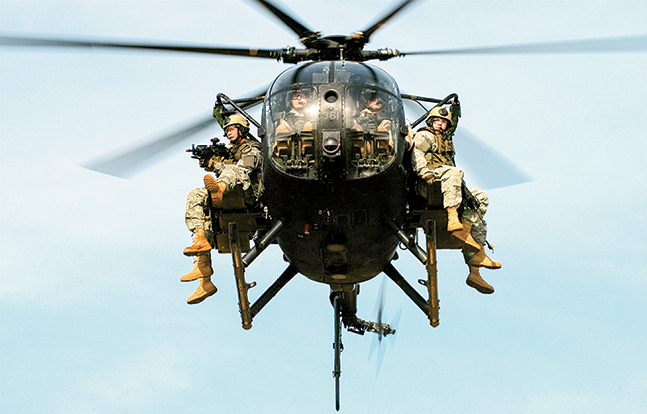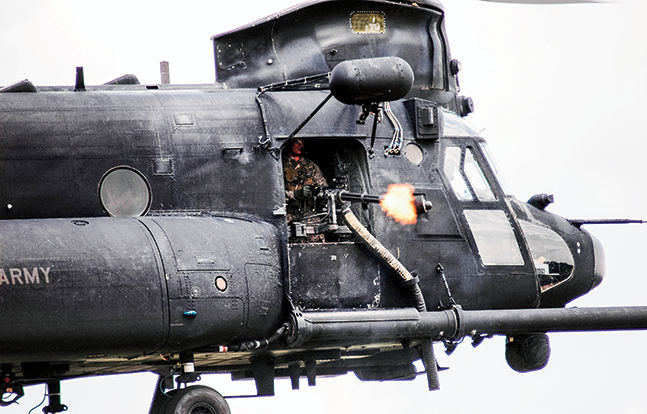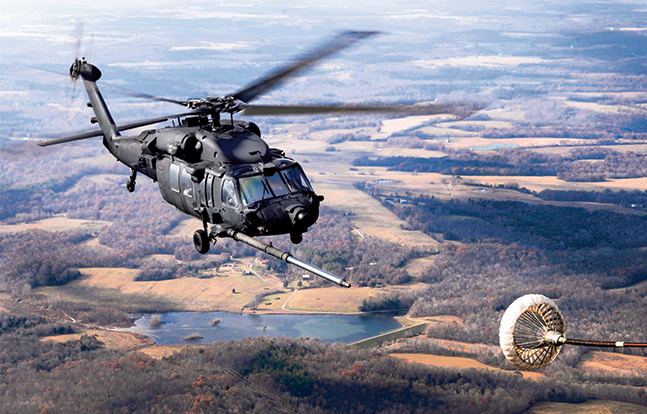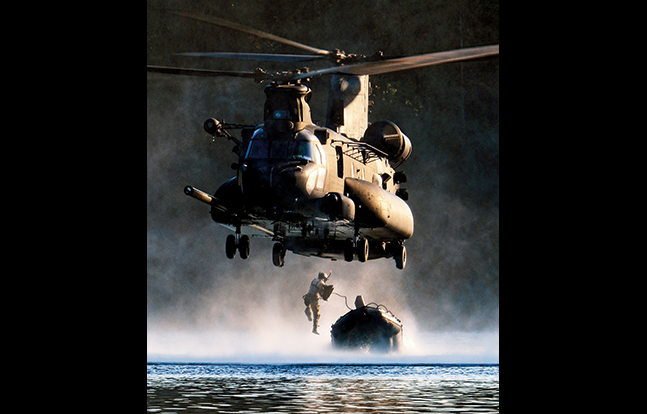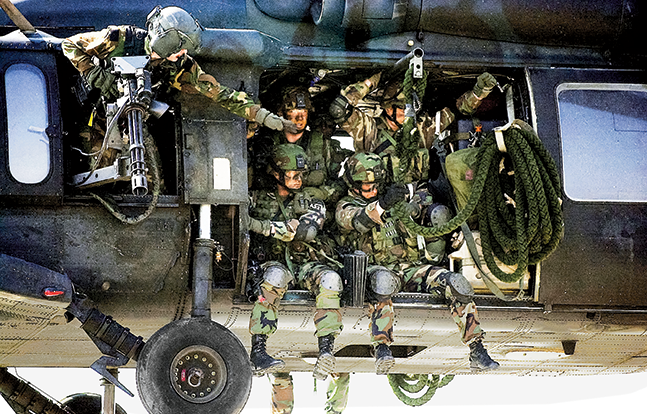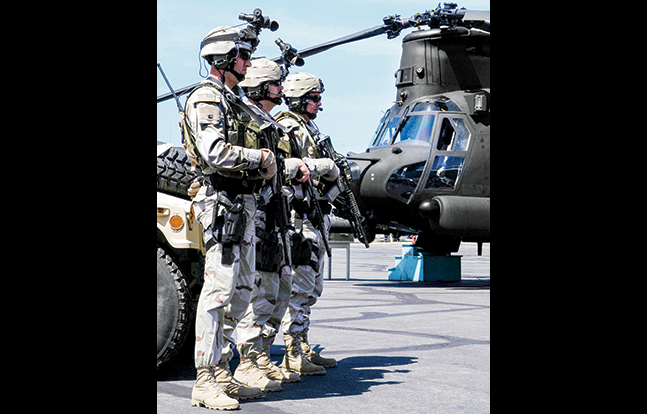After the 1980 mission to rescue American hostages from Iran was aborted due to helicopter problems, the U.S. Army began developing a helicopter component structured and trained to support special operations. When officially activated in October 1981, it was designated the 160th Aviation Battalion. Many of the original personnel came from the 101st Airborne Division. Over the next decade, the unit would evolve and be designated the 160th Special Operations Aviation Regiment (Airborne), or SOAR, in May of 1990. From Operation Urgent Fury in 1983 through current operations around the world, the 160th SOAR has been involved wherever U.S. special operators have been committed. Long-range, low-level penetrations are a specialty of 160th SOAR crews.
The 160th SOAR has the mission of infiltrating behind enemy lines or into other denied territory to insert or extract U.S. or allied special operations personnel. SOAR helicopters may also be used for resupply, close air support or medical evacuation of special operations personnel.
Making The Cut
Advertisement — Continue Reading Below
The 160th SOAR recruits among pilots who have completed at least one full tour after flight school. Its considered desirable for recruits to have flown 1,000 hours—100 of them using night-vision equipment—but it’s not required. Enlisted personnel are recruited from among those possessing the maintenance and other support skills needed in the 160th SOAR. Before being selected for the 160th SOAR, pilots attend a weeklong assessment at Fort Campbell, Kentucky, where physical, mental and emotional evaluations are given. Physical tests include swimming in full flight gear with a helmet.
“The 160th SOAR has the mission of infiltrating behind enemy lines or into other denied territory to insert or extract U.S. or allied special operations personnel.”
Officers and enlisted personnel assigned to the 160th SOAR must first be assigned to the training unit: Green Platoon. Enlisted personnel undergo five weeks of training and officers attend eight months’ worth. Among the skills covered are CQB with weapons, hand-to-hand combat, escape and evasion, survival on land and in the water, and other useful skills for personnel who will be flying dangerous missions. Many members of the 160th SOAR will attend airborne and air assault schools. Since the 160th SOAR specializes in flying low and at night, pilots spend much of their initial training time sharpening these types of skills. By the time they join their operational battalion they have earned the right to be called “Night Stalkers.”
Advertisement — Continue Reading Below
The 1st and 2nd Battalions of the 160th SOAR are based at Fort Campbell, Kentucky, as is the Training Company, while the 3rd Battalion is based at Hunter Field, Georgia. In 2005, a fourth battalion was formed at Fort Lewis, Washington. There are also companies assigned to Southern Command and at times Pacific Command, and elements are assigned to work with the Combat Applications Group (Delta) on anti-terrorist missions. During the Global War on Terror, elements of the 160th SOAR were based in Iraq and Afghanistan.
This is a general look at 160th SOAR organization. In actuality, companies will be organized to fit the missions and operational area of those operators they support. Although U.S. Navy SEALs have their own helicopter support, 160th SOAR sometimes works with them as well. In fact, 160th SOAR pilots learn to carry out operations from aircraft carriers. Probably the best-known operation carried out by the 160th SOAR with the SEALs was the May 2011 raid on Osama bin Laden’s compound. Reportedly, special stealth versions of the Black Hawk helicopter were used on the raid.
Taking Flight
Advertisement — Continue Reading Below
The 160th SOAR operates three types of helicopters. Perhaps the one most familiar to many readers is the MH-6 or AH-6 Little Bird. The MH-6s are the small gunships used so effectively in the Battle of Mogadishu and shown in the film Black Hawk Down. The MH-6 is a light utility helicopter modified to transport up to six troops on outboard “benches” along its sides. At least some MH-6s incorporate forward-looking infrared radar (FLIR) systems for night operations and intelligence gathering. The MH-6 may be configured for fast-roping and STABO (Stabilized Body) operations. The MH-6’s minimal size allows it to insert small teams of operators directly onto buildings or other targets. The small size also makes it easily deployable by transport aircraft; a C-141 can transport six Little Birds and a C-130 can transport three. Within 15 minutes of unloading them, the helicopters are mission ready.
The AH-6J is the light attack version of the Little Bird and can be armed with a selection of 7.62mm miniguns, 70mm rocket pods, .50-caliber machine guns, Hellfire missiles, 30mm cannons or Stinger air-to-air missiles. An enhanced MH-6M version is due to become the standard Little Bird attack helicopter by 2015. Many 160th SOAR AH-6 pilots were formerly Cobra pilots who find the AH-6’s ability to use diving fire to get up close and personal with their targets a real rush.
The 160th SOAR also uses three types of MH-60 Black Hawk helicopters. The MH-60K is a special operations utility helicopter that incorporates aerial refueling capability, advanced survivability equipment and improved navigation systems to allow for accurate flying in bad weather or other adverse conditions. The MH-60L is another utility version designed for special operations, while the MH-60L Direct Action Penetrator (DAP) version is designed to offer fire support to operators or carry out strike missions. Weapons with which the MH-60L DAP may be equipped include 30mm chain guns and M134D Gatling guns. The latter may be operated as fixed, forward-firing weapons or as door guns. The helicopter can also deploy precision-guided munitions. The MH60L DAP can carry out armed infiltration missions and can also act as an armed escort for other 160th SOAR helicopters. As with other 160th SOAR MH-60s, the MH-60L version can operate in all types of weather and over rough terrain due its sophisticated radar and other navigation aids.
Advertisement — Continue Reading Below
The heaviest 160th SOAR helicopter is the MH-47G Chinook, an upgraded version of the MH-47E. The MH-47D is designated the “Adverse Weather Cockpit” version and is designed for use in all types of weather. The MH-47D or E variant may be used to insert a substantial number of operators at one time by landing or hovering, fast-roping or parachute insertions. The heavy lift capability also allows the MH-47 to carry out sling operations to deliver or remove equipment. The MH-47E incorporates many redundant avionics systems for survivability on missions. It may also be aerially refueled. Both MH-47s may be equipped with a fast-rope insertion/extraction system, an internal rescue hoist, an external rescue hoist and an external cargo hook. Both have FLIR and other sophisticated navigation systems. The MH-47G, which will replace many 160th SOAR birds over the next few years, includes enhanced avionics and navigation equipment as well as better hardening and M134 miniguns and M240D machine guns to give it more firepower.
To aid in survivability, larger SOAR helicopters may be equipped with an active-radar Missile Approach Warning System (MAWS) coupled with an air-launched countermeasures dispenser to dump chaff and flares. High on the wish list of items that will enhance survivability are an acoustic detection system to alert aircrews if they are being engaged by small arms; better, lightweight ballistic protection for personnel and critical components; and better cockpit protection.
Mission-Ready 24/7
Advertisement — Continue Reading Below
Pilots and crewmembers of the 160th SOAR have sophisticated night-vision goggles and systems and high-tech navigation systems. Pilots can navigate precisely to their objective in total darkness flying nap-of-the-earth. Their aircraft have survivability packages and their own defensive firepower. Nevertheless, 160th SOAR crews operate in dangerous situations in areas controlled by the enemy. As a result, they must be trained to fight or escape and evade should their bird go down.
In the past, 160th SOAR crewmembers were armed with HK MP5K submachine guns that they carried in special Eagle Industries quick-release thigh holsters, often with a piece of paracord tied to the stock and also affixed to the webbed gear. Just drawing the submachine gun and thrusting it towards a target would deploy the stock. Normally one of the short 15-round magazines was carried in the MP5K. A spare magazine pouch carrying four magazines was carried on the opposite thigh. However, 160th SOAR pilots now carry the same weapons as many of the operators with whom they work—an M9 pistol and an M4 Carbine. Often, 160th SOAR crewmembers do their firearms training along with the Rangers or Special Forces with whom they work and achieve quite a high level of competency.
SOCOM operators are trained to carry out a wide range of missions behind enemy lines and in dangerous circumstances. However, a good portion of the time they have to be inserted and extracted to carry out those missions. Many times, the extraction can be particularly difficult. That’s why the motto of the 160th SOAR is “Night Stalkers Don’t Quit.”
Advertisement — Continue Reading Below
